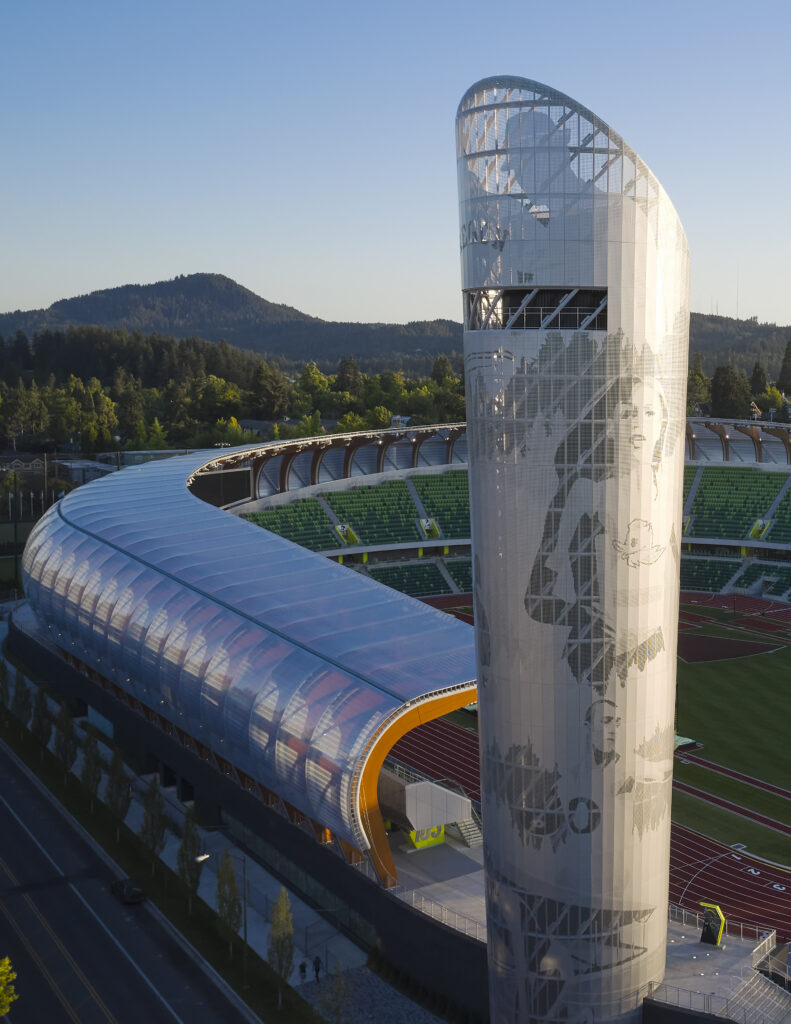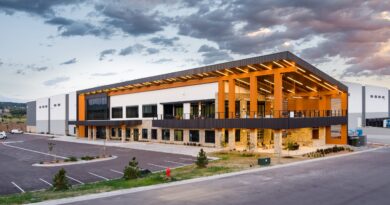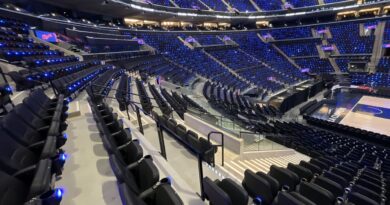Hayward Field
Reimagined Track & Field Facility at University of Oregon
by Jeff Yrazabal, principal, at SRG Partnership
Envisioned as the finest track and field facility in the world, the reimagined Hayward Field is designed to give University of Oregon’s championship caliber student athletes, and athletes from around the world, an unparalleled stage on which to push the limits of what is possible. A true theater for track, Hayward Field sets a new standard for fan experience and connection to the sport with comfortable seating for every single patron, a diversity of in-stadium food and beverage amenities, great sight lines, and close proximity to the athletes and the action.
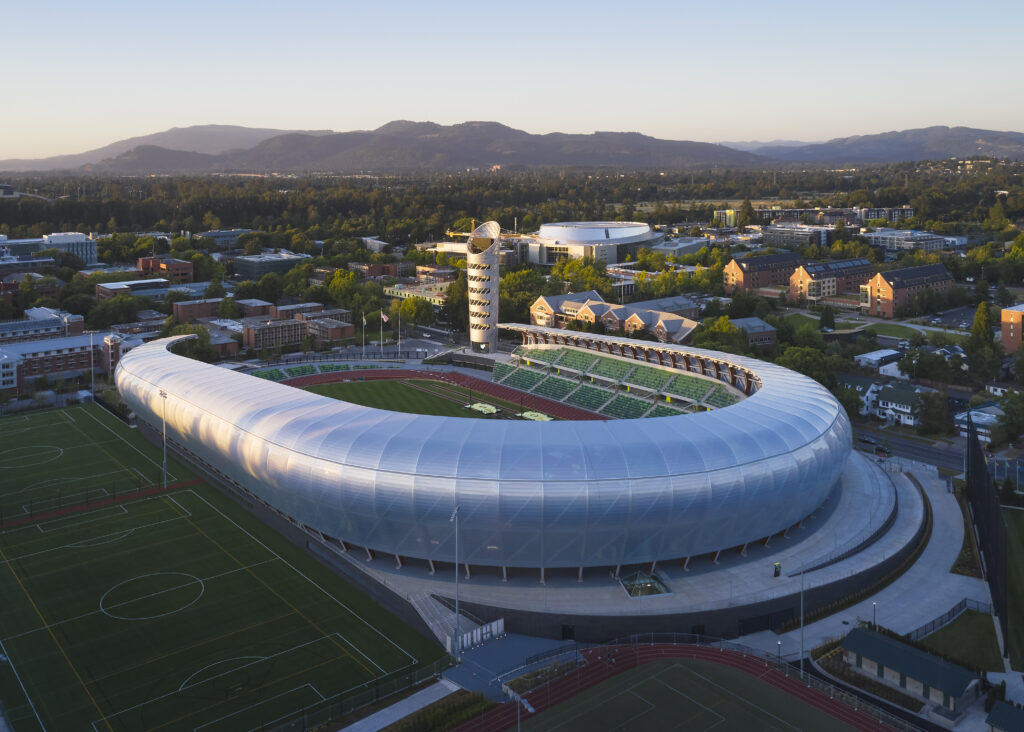
Hayward Field is an historic place, even magic to all of track and field’s faithful across the world. To Phil Knight, co-founder of Nike Inc. and former middle-distance runner for the University of Oregon Ducks, “This is where it all began.” It was here the great Bill Bowerman, Knight’s mentor and co-founder of Nike, coached monumental athletes like Steve Prefontaine. While this history of greatness still feeds the University of Oregon’s bold, rebel-like brand today, the school’s athletics programs have always been driven by innovation and new ideas. The redesigned Hayward Field builds on this legacy by both acknowledging the past while providing a bold vision for the future and the magic yet to come.
The Athlete’s Experience
The 12,650-seat stadium, which is expandable to nearly 25,000 seats, provides world-class facilities for the University of Oregon’s track and field student-athletes to train, develop, and perform at their highest potential. All aspects of the stadium beyond the competitive track were envisioned to be used by the athletes for training, from the public concourses and ramps totaling 84,085 sq.ft., which are covered in track surfacing, to winding vertical stairs climbing the soaring Hayward tower. Beneath the stadium is nearly 40,000 sq.ft. dedicated to training and recovery, including several amenities for the athletes to be social and come together as a team. Examples of these team amenities beneath the stadium include: an indoor practice area, including a six-lane, 140-meter straightaway and two-story interior space for long jump, triple jump, throws, and pole vault; 100-seat team auditorium; team locker rooms, lounge and shared study spaces; weight training; equipment work-space, offices, storage and check-out; sports medicine and active/passive recovery; hydrotherapy, training, and treatment; anti-gravity treadmills; nutrition station; and barber shop. “Every inch of it can be used as a training facility, so no more having to schedule time or share facilities with other sports,” said Whitney Ranson, architect, SRG Partnership, Portland, Oregon. “Anything that can be used as a training tool is used as a training tool.”
Spectator Connection & Experience
In addition to the athlete’s experience, the fan experience was paramount to the design. Open sight lines for all and the proximity of the spectators to the athletes, with the first row of seats on the new nine-lane track level, creates a unique intimacy between athletes and fans. The enhanced acoustics of the stadium help build anticipation and amplify the action, creating an immersive sensory experience. “We decided to go with a single layer of ETFE and stretch it taught, so it becomes kind of a diaphanous, simple form that sits on this solid masonry base,” SRG principal Rick Zieve said of the stadium’s cladding. “It goes from more transparent down lower on the building to more fritted as you move up to the roof, so you get better shading. ETFE is a bright acoustical material, so it really helps reinforce and amplify sound. It was loud at the old Hayward, but there wasn’t enough enclosure to really amplify it.”
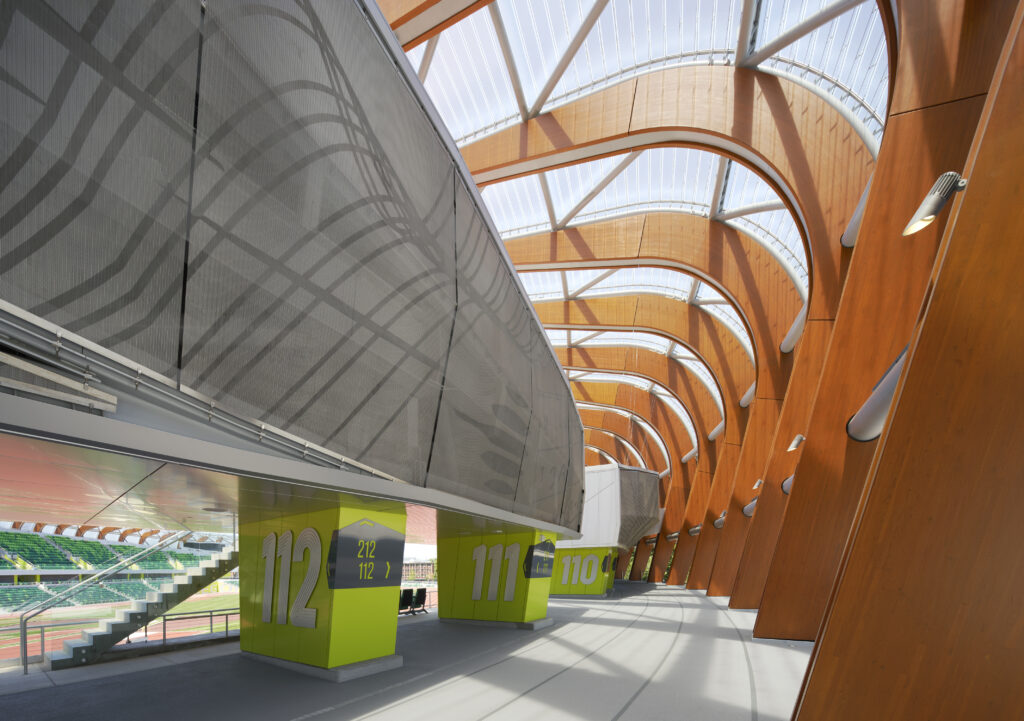
Throughout the stadium all seating is a spacious 22” wide, with a generous 44” tread depth for optimum fan comfort. Making the stadium unique as a Track and Field only venue, the seating bowl is asymmetrical to pack the most fans near the finish line of competition. Unlike typical suites that are in lofty boxes above the stands, Hayward’s premium suites are open and close to the field, directly connecting fans to the action. “Track and field has the biggest competition surface of any sport,” said Aaron Pleskac, principal at SRG Partnership. “The stadium is a theater.”
A Connection To History
While track and field competition brings the fans to Hayward Field, there is more to experience here than simply the sporting events. Designed in collaboration with Gallagher, Portland, an 8,600-sq.ft. museum dedicated to the history of Oregon Track and Field tells the story of Bowerman and the birthplace of Nike. Inspirational graphics and monuments weave throughout the venue highlighting former Duck athletes and elements of the iconic Oregon brand. For example, the metal mesh that wraps the underside of the seating bowl highlights original sketches from Bowerman, innovator and creator of the original Nike shoes. His historic statue is also located outside the museum, sitting directly on the track and the third curve, allowing him to see all the athletes who will run by him. Salvaged from the historic Hayward Field, plaques dedicated to Bowerman’s memory are located throughout the newly designed 15th Avenue promenade and at the gateway threshold from the plaza to the site. To commemorate the nations of athletes who have competed at Hayward, a dramatic procession of 156 flags line the perimeter of the south side of the stadium. Together, the people, stories, and elements of what has made Oregon Track and Field iconic and championship caliber through the years provides context to this special place and inspiration for young, aspiring student-athletes.
The Significance of Wood
When first conceptualizing the new Hayward Field, the design team came across the quote, “Oregon is Wood and Wood is Oregon,” by Bowerman, inspiring the heroic wood canopy structure and other wood elements throughout the stadium. The soaring canopy structure, or bents, surrounding the stadium are a powerful connection to Oregon and the Pacific Northwest. At the same time, this heroic scale structure is a physical representation of the most important aspect of the University of Oregon brand: innovation. Paired with the light, airy, translucent ETFE canopy roof, this environment enhances acoustics and provides rain protection and shade for the fans below.
Hayward Tower
The nine-story Hayward Tower marks the main public entry and serves as a campus and community-wide landmark for this historic site. The interior includes coaches’ amenities, offices, and meeting rooms and the open upper deck will be made public for all Hayward visitors to enjoy the 360º view of Eugene, Oregon, and the surrounding valley. The exterior is clad with a perforated metal panel featuring imagery of five Oregon track and field icons: legendary coach Bill Bowerman, Steve Prefontaine, Raevyn Rogers, Ashton Eaton, and Otis Davis. The steel form flares upward and outward to resemble the Olympic torch, a fitting nod to the success Oregon Athletes have had and will continue to have on the biggest of competitive world stages.
